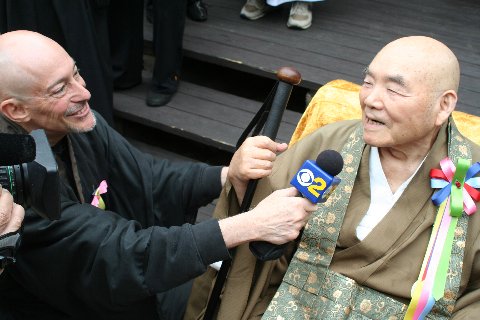Update 3/13/13: Please note that Dharma Heritage has removed from their site the video that this post was written about. I hope you’ll still find the other materials useful.
Great souls communicate their gifts to humanity in three ways:
• Through their concepts.
• Through their conduct.
• Through their contour.
Their concepts are powerful ideas expressed in words. Their conduct is how they deal with real-life situations and challenges. Their contour is their energy—how they are able to express the flow of nature/spirit/space/no self/true self through their movements, gestures, gaze and voice quality.
Powerful concepts inform us but can also inspire us. Admirable conduct inspires us but can also inform us. Likewise for the contour of energy that envelops that content—you can be both energized and educated by it.
The concepts and conduct of great souls can be passed down through the written word. But what about their contour? Learning from the teacher’s energy is highly valued in some traditions (most conspicuously Zen and certain forms of Hinduism). In the Japanese language, this is referred to as ishindenshin (transmission of consciousness by consciousness).
In pre-modern times, there was little one could do to preserve the energy contour of an enlightened being. The closest one might come would be realistic portraits or statues that capture some of those dynamic qualities. Indeed, I have heard it said (but I can’t remember by whom; maybe one of you knows) that the first appearance of realistic portrayal of human form in East Asia was driven by the desire to preserve the essence of meditation masters. (Another way was to mummify.)
But now things are completely different because you can get videos of great souls and learn directly from their dynamic essence. Below you’ll find a link to one such video. It’s actually a sizzle reel to promote a longer feature length movie that I sincerely hope eventually gets made. The video is short but it still packs a punch. It contains several vignettes with Joshu Sasaki Roshi, the Zen master who has so profoundly influenced the way I teach. Interspersed with these are interviews with Leonard Cohen and others talking about Roshi. If you’re sensitive to such things, you should be able to “cop a vibe” from how Roshi effortlessly rides on the flow of expansion and contraction. In the video Roshi mostly talks about “where things go to when they vanish.” Two of Leonard Cohen’s songs are played in the background: “Ballad of the Absent Mare,” and “Love Itself.”
Here’s the link: http://www.dharmaheritage.org/dharmaheritage/Projects.html: (3/13/13: link no longer works; please see the update at the top of this post)
And here are some resources that might help enhance your appreciation of it.
I talk about “where things go” here and here.
I talk about expansion and contraction here and here.
Leonard’s “Love Itself” is a description of dissolving into “Flow and Gone.” I talk about it and play it (with Leonard’s personal permission!) here:
- Leonard Cohen, Sasaki Roshi, & “Love Itself” – Part 1 of 2
- Leonard Cohen’s “Love Itself” – Part 2 of 2
The lyrics can be found here.
The Ballad of the Absent Mare is Leonard’s contemporary reworking of the Ten Ox Herding pictures. (Ox is replaced by mare; herding boy is replaced by cowboy.) Check out my talk about the Ox Herding pictures here: Part 1, Part 2, and Part 3 (sorry about the technical quality on these videos. They were the first Youtube videos we shot ☺).
You may have heard about how blows from sticks are used to spur Zen students forward. You’ll see that briefly in the Dharma Heritage video. The stick is called a keisaku. For fun, check out this hilarious clip of my colleague Soryu using a keisaku to whack the crap out of me. ☺
Roshi is, at this writing, 105 years old. Here are some photos of me interviewing him for CBS on his 100th birthday. (Thanks to Dan B. Wood of the Christian Science Monitor and Stephanie Nash for these photos, and as always to Har-Prakash Khalsa for the Expand-Contract Youtube channel and videos.)




